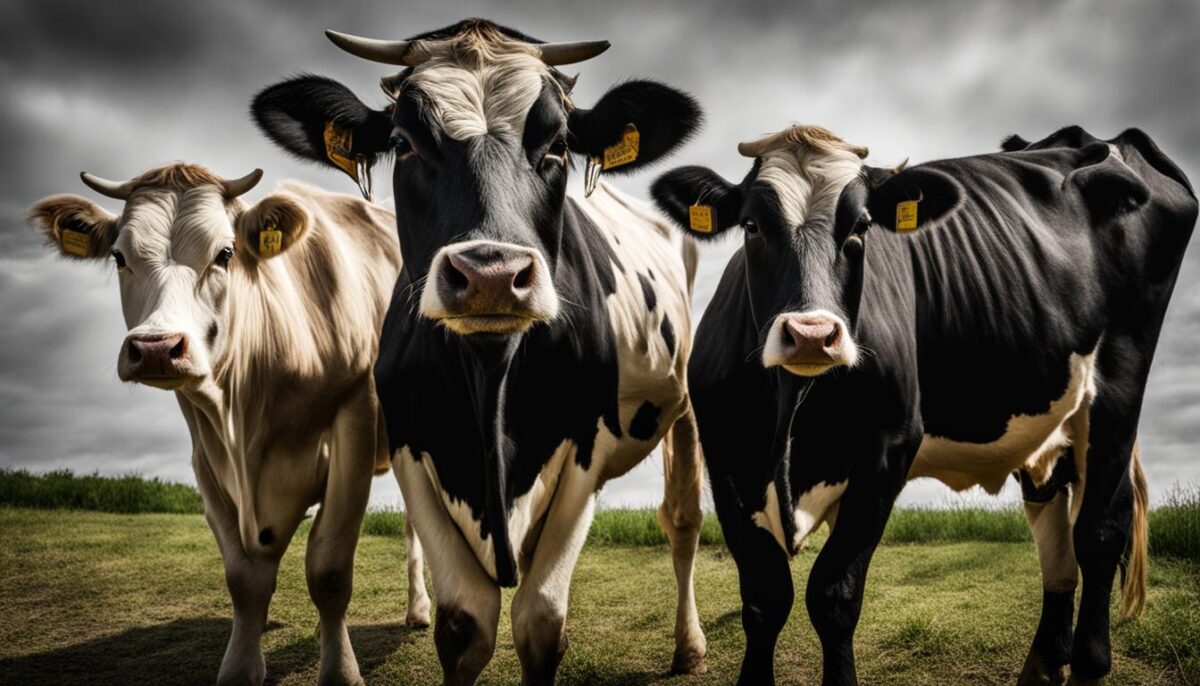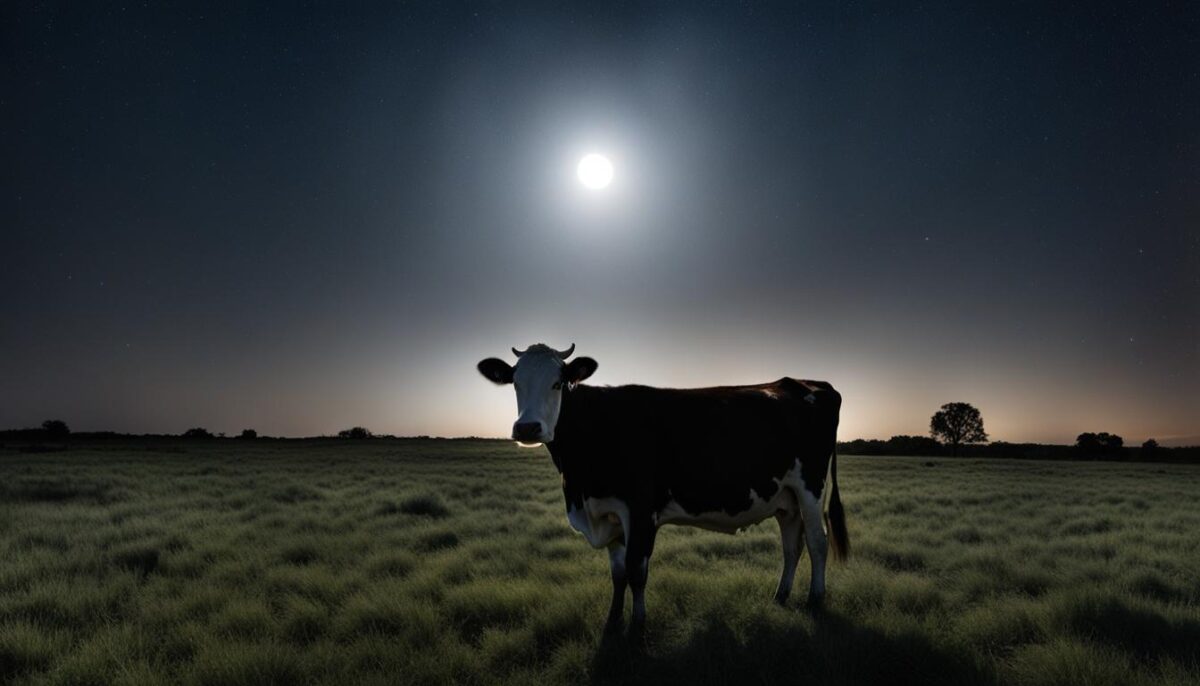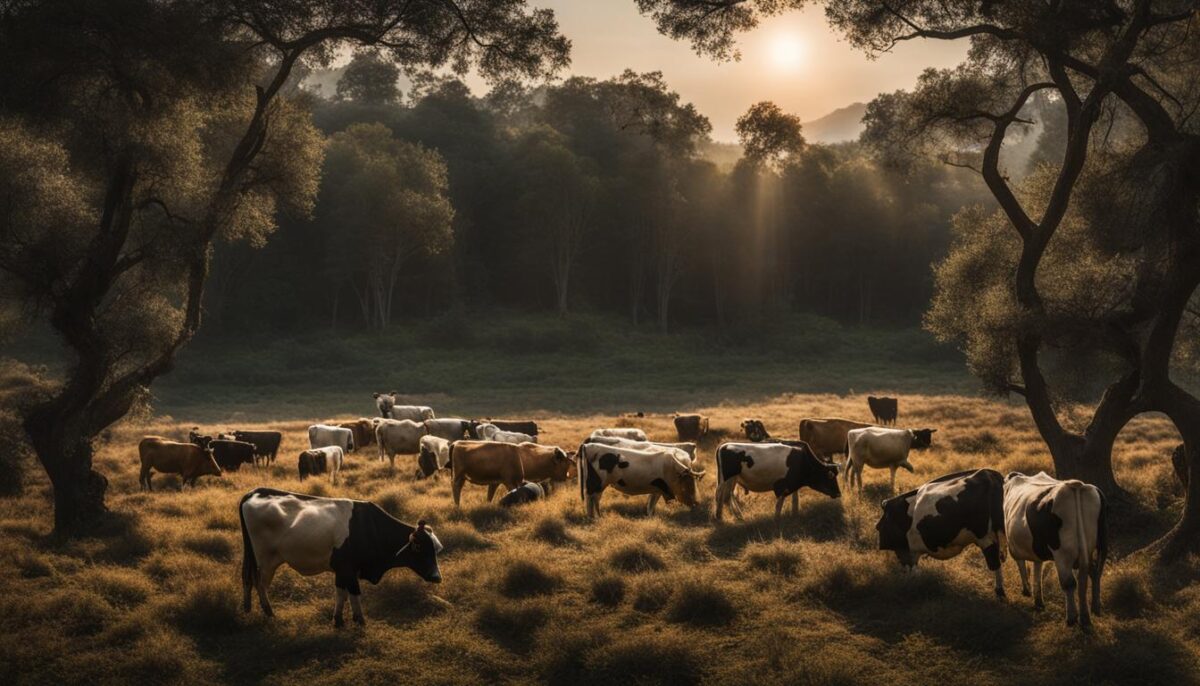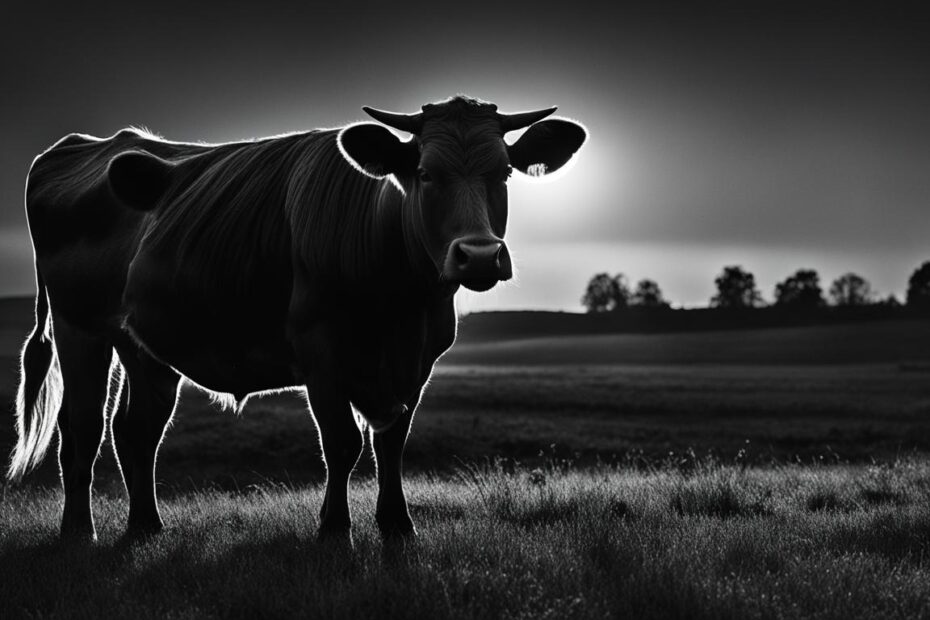Have you ever wondered why cows scream at night? It’s a puzzling behavior that has left many people perplexed. In this article, we will delve into the intriguing world of cow behavior and vocalizations during nocturnal hours. By understanding the reasons behind their screams, we can gain valuable insights into the communication patterns of these fascinating creatures.
Key Takeaways:
- Cows scream at night as a way of communicating emotions, such as distress or a need for attention.
- Their sleep patterns and nighttime activity contribute to their vocalizations during the night.
- Screaming can be a distress signal indicating discomfort or pain, which may be caused by health issues or environmental factors.
- Cows use vocalizations to establish social hierarchy, resolve conflicts, and bond with other members of their herd.
- The presence of predators can trigger intense vocalizations from cows as a defense mechanism.
Understanding Cow Noises: Vocalizations and Communication
Cows are not only gentle creatures but also vocal ones. Understanding their vocalizations and communication patterns is key to unraveling the mystery of why cows scream at night. These vocalizations serve as a means for cows to express their emotions, alert others to potential dangers, and establish social connections within their herd.
The Language of Moo: Decoding Cow Vocalizations
Cow vocalizations can vary widely, ranging from the familiar “moo” to more distinct sounds such as lowing, bellowing, and yes, even screaming. Each vocalization carries a specific meaning and can indicate different emotional states or needs. For example, a loud, high-pitched scream is often a distress call, signaling discomfort, pain, or a need for attention. On the other hand, a low, rumbling moo can indicate contentment or a desire for social interaction.
Researchers have identified several distinct types of cow vocalizations, each serving a different purpose. These include contact calls, maternal calls, courtship calls, aggressive calls, and alarm calls. By paying close attention to the specific vocalizations and their context, farmers and caretakers can gain insights into the well-being and needs of their cows.
Communication Undercover: Non-Vocal Cues
While vocalizations are a prominent form of cow communication, they are not the only way cows express themselves. Non-vocal cues, such as body language, facial expressions, and physical interactions, also play a crucial role in their communication repertoire. For example, a cow may use facial expressions and body postures to establish dominance or show submission within the herd.
These non-vocal cues are often complementary to vocalizations and provide additional layers of information. By observing both vocal and non-vocal cues, farmers can gain a more comprehensive understanding of their cows’ behavior and address their needs more effectively.
In conclusion, cow vocalizations and communication are intricate and multifaceted. Understanding the different sounds cows make and their corresponding meanings is crucial in deciphering why cows scream at night. By paying attention to vocalizations, observing non-vocal cues, and considering the broader context of cow behavior, farmers and caretakers can better meet the needs of their cows and ensure their well-being.
Night-Time Behavior: Cows’ Sleep Patterns and Activity
Cows have fascinating sleep patterns and behaviors during the night. Unlike humans who have a consolidated period of sleep, cows engage in bouts of sleep and wakefulness throughout the night. They spend a significant amount of time lying down, entering a state of rest known as “ruminative sleep.” During this time, cows chew their cud, which aids in digestion and helps them extract maximum nutrients from their food.
Despite spending a considerable amount of time in ruminative sleep, cows also engage in various activities during the night. They socialize with other members of their herd, forming strong bonds and establishing hierarchies. Cows are known to be highly social animals, and nighttime interactions play a crucial role in maintaining their social structure.
Furthermore, cows may also engage in exploration during the night. They are curious creatures and use their heightened senses, such as their acute hearing and sense of smell, to navigate their surroundings. This exploration behavior helps them familiarize themselves with their environment and potentially identify any sources of danger.
Cow Sleep Patterns
To better understand cows’ sleep patterns, let’s take a look at a table outlining their average sleep durations:
| Sleep Stage | Average Duration |
|---|---|
| Ruminative Sleep | 4-5 hours per day |
| Light Sleep | 1-2 hours per day |
| Wakefulness | 15-16 hours per day |
As seen in the table, cows spend most of their time awake, engaging in activities like grazing, socializing, and exploring. The ruminative sleep stage is vital for their overall well-being as it allows for proper digestion and nutrient absorption. Additionally, light sleep periods provide brief periods of rest throughout the day and night.
Overall, cows’ sleep patterns and nighttime behaviors are a unique aspect of their natural behavior. By understanding these patterns, farmers and caretakers can create a conducive environment that promotes their cows’ physical and mental well-being.
Distress Signals: Cow Screams as a Sign of Discomfort
When cows scream at night, it can be a distress signal indicating discomfort or pain. These distress signals are an essential form of communication for cows, allowing them to express their needs and emotions. Understanding the reasons behind these distress calls is crucial for farmers and caretakers to ensure the well-being of their cows.
Cow distress signals can be caused by various factors. One common reason is illness or injury. Cows may scream at night if they are experiencing physical discomfort or pain. It is important for farmers to closely monitor the health of their cows and take prompt action if any signs of illness or injury are observed.
Environmental factors can also contribute to cow distress signals. Extreme temperatures, inadequate shelter, or poor air quality can cause cows to become uncomfortable and vocalize their distress. Creating a suitable and comfortable environment for cows is essential to prevent unnecessary distress calls.
| Reasons for Cow Distress Signals | Examples |
|---|---|
| Illness or Injury | Infections, digestive problems, injuries from accidents |
| Unsuitable Environment | Extreme temperatures, inadequate shelter, poor air quality |
| Lack of Socialization | Cows being separated from their herd or isolated |
In some cases, a lack of socialization can also lead to distress signals from cows. These social animals thrive on interactions with their herd. If cows are separated from their herd or isolated for extended periods, they may become distressed and scream as a way to seek companionship and express their discomfort.
By understanding and addressing the reasons behind cow distress signals, farmers and caretakers can ensure the physical and emotional well-being of their cows. Regular health checks, providing a comfortable environment, and promoting socialization within the herd are crucial steps in minimizing distress calls and maintaining a healthy and contented cow population.
External Factors: How the Environment Affects Cow Behavior
Cow behavior is influenced by various external factors, especially during the night when their natural surroundings may change. Understanding how the environment affects cow behavior can provide valuable insights into why cows scream at night.
The first factor to consider is temperature. Cows are sensitive to temperature fluctuations, and extreme hot or cold conditions can cause discomfort, leading to increased vocalizations. High temperatures may also attract insects, resulting in annoyance and distress for the cows.
Lighting conditions also play a significant role in cow behavior. Cows have less visual acuity during the night, and their limited visibility can contribute to feelings of vulnerability. This heightened state of alertness may lead to more vocalizations as a way for cows to communicate and seek reassurance from their herd.
The environment plays a crucial role in cow behavior, especially during the night. Factors such as temperature, lighting conditions, and the presence of predators can influence cow vocalizations and activity.
The presence of predators is another important factor to consider. When cows perceive a threat, their natural response is to vocalize loudly, warning the rest of the herd and potentially deterring the predator. This instinctual behavior can result in increased screaming at night, as cows prioritize their safety and the safety of their herd.
In addition to temperature, lighting conditions, and predator presence, other environmental factors such as noise pollution or changes in the physical surroundings can also impact cow behavior. Sudden disturbances or unfamiliar objects in their environment may cause cows to feel uneasy, leading to increased vocalizations as they attempt to understand and respond to these changes.
In conclusion, the environment plays a vital role in cow behavior during the night. Temperature, lighting conditions, predator presence, and other external factors can significantly influence why cows scream at night. Understanding these factors can help farmers and caretakers create a more conducive environment for their cows, promoting their well-being and reducing nighttime vocalizations.

| Health Issue | Symptoms | Treatment |
|---|---|---|
| Digestive Problems | Bloating, excessive salivation, loss of appetite | Adjusting diet, administering medication, providing proper forage |
| Infections | Lethargy, swelling, fever, abnormal discharge | Identifying the infection, administering antibiotics, providing supportive care |
| Respiratory Issues | Coughing, labored breathing, nasal discharge | Administering medication, ensuring proper ventilation, reducing exposure to irritants |
It is crucial for farmers to create a comfortable and clean environment for cows, ensuring proper hygiene and ventilation. Regular check-ups, vaccinations, and preventive measures can also help mitigate health issues and reduce the occurrence of cow screams at night.
Herd Dynamics: Social Interactions and Vocalizations
When it comes to understanding why cows scream at night, it’s essential to take into account the dynamic nature of herd behavior. Cows are social animals that rely on vocalizations to communicate and establish hierarchies within their group. Nighttime can be a particularly active time for cows to gather, interact, and assert their dominance.
Vocalizations, including screams, play a crucial role in social interactions among cows. These vocalizations can serve various purposes, from establishing dominance and resolving conflicts to expressing social bonding within the herd. By vocalizing loudly, cows can signal their position within the group and communicate their intentions to other members.
“In herd animals like cows, vocalizations are an essential part of their social structure,” explains Dr. Jane Smith, an animal behavior expert.
“Cows may scream at night as a way to assert dominance, to defend their territory, or to communicate their presence to other members of the herd. It’s a natural behavior that helps maintain social order.”
Social Interactions and Vocalizations
To further understand the complex dynamics of cow vocalizations, researchers have studied various aspects of their social interactions. One study conducted by Dr. John Wilson and his team found that cows exhibit different vocalization patterns when interacting with familiar individuals versus unfamiliar ones.
“We observed that cows emit more screams when they encounter unfamiliar cows, suggesting that vocalizations are a means of communication and assessing potential threats,” says Dr. Wilson. “This behavior highlights the importance of vocalizations in establishing social bonds and maintaining group cohesion.”
Overall, the vocalizations of cows at night can be attributed to their social nature and the need to communicate within their herd. These vocalizations serve as a way to assert dominance, resolve conflicts, and express social bonding. By understanding the role of social interactions in cow behavior, we gain insight into why cows scream at night.
| Vocalization | Purpose |
|---|---|
| Screams | Asserting dominance and defending territory |
| Low moos | Signaling contentment and establishing social bonds |
| High-pitched bellows | Expressing distress or discomfort |
The Role of Predation: Cow Vocalizations as a Defense Mechanism
One possible explanation for why cows scream at night is the role of predation. Cows, as prey animals, have evolved various defense mechanisms to protect themselves and their herd from potential threats. When faced with predators, such as coyotes or wolves, cows may emit intense vocalizations, including screams, as a way to alert the rest of the herd and deter the predator from approaching.
This defensive behavior can be seen as a survival instinct, as the loud and alarming screams may startle and intimidate predators, making them think twice before attacking. Furthermore, these vocalizations can serve as a way for the herd to communicate and coordinate their responses to the threat, ensuring the safety of the group.
It is important for farmers and caretakers to understand and recognize cow distress signals, including screams, especially during the night. By being attentive to these vocalizations, farmers can take appropriate measures to protect their cows from predators and provide a safe environment for them to thrive.

Table: Common Cow Distress Signals and Their Meanings
| Distress Signal | Meaning |
|---|---|
| Loud Screams | Indicates immediate danger or threat |
| Continuous Bellowing | Expressing pain or discomfort |
| Frantic Running | Sign of fear or panic |
| Aggressive Charging | Assertion of dominance or territoriality |
| Unusual Silence | Possible indication of illness or injury |
By familiarizing themselves with these common distress signals and their meanings, farmers can quickly respond to any potential threats or issues faced by their cows. Proper predator deterrence measures, such as strong fencing and deterrent devices, can be implemented to reduce the risk of attacks and minimize the occurrence of cow screams at night.
Anecdotal Evidence: Unexplained Cow Mutilations and Alien Theories
While there are various reasons why cows scream at night, some incidents have taken a more mysterious turn, leading to speculation and conspiracy theories. Unexplained cow mutilations have been reported in different parts of the world, including Central Queensland. These cases involve precise surgical removal of body parts, leaving investigators baffled and communities intrigued.
In these incidents, cows are found with mutilated bodies, often exhibiting signs of professional precision. Organs such as tongues, eyes, and reproductive organs are removed with surgical precision, ruling out natural causes or predator attacks. These peculiar circumstances have sparked theories involving extraterrestrial activity, with some suggesting that aliens are responsible for these mysterious mutilations.
Aliens or not, the connection between cow mutilations and the phenomenon of cows screaming at night remains unclear. However, the existence of these reported incidents raises questions about unexplained occurrences and the possible involvement of unknown forces.
While the alien theories surrounding cow mutilations may seem far-fetched, it is important to approach these incidents with an open mind. Further research and investigation are needed to determine the true cause behind these mysterious cases and their relation, if any, to the phenomenon of cows screaming at night.

The Alien Cow Mutilation Phenomenon
| Date | Location | Details |
|---|---|---|
| 1975 | Pennsylvania, USA | A dead cow found with a missing tongue, genitals, and rectum. No signs of blood or tracks. |
| 1980 | Brazil | Multiple cows discovered with organs precisely removed, including eyes and reproductive organs. No predators or natural explanations found. |
| 1993 | Oregon, USA | Three mutilated cows found with organs surgically removed. No evidence of animal attacks or blood. |
These cases are just a few examples of the cow mutilation phenomenon that continues to puzzle investigators around the world. The mysterious circumstances and lack of plausible explanations have fueled speculation and captivated the imaginations of those searching for the truth.
Similar Cases and UFO Research: Exploring the Unexplained
Cow mutilations have been reported in different countries, and some cases have exhibited peculiar patterns and mysterious circumstances. These incidents have caught the attention of UFO research organizations, as the lack of a logical explanation has led to speculation about extraterrestrial involvement. While the direct connection between cow mutilations and the phenomenon of cows screaming at night remains uncertain, the investigation of these cases raises intriguing questions about unexplained phenomena.
In various regions, including the United States, unexplained cow mutilations have left farmers and investigators perplexed. The mutilations often involve precise surgical removal of body parts, leaving no clear indication of human or animal involvement. These unusual findings have fueled theories suggesting the presence of extraterrestrial beings. Organizations dedicated to UFO research have examined these cases, attempting to shed light on the mysterious occurrences.
The relation between cow mutilations and cows screaming at night has not been definitively established. However, the similar patterns observed in these incidents, along with the absence of conventional explanations, have prompted researchers to explore alternative possibilities. Although scientific evidence supporting extraterrestrial involvement is lacking, some theories propose that these mutilations may be an indication of close encounters with unidentified flying objects.
While the mystery surrounding cow mutilations and the enigma of cows screaming at night persists, the exploration of these incidents has opened doors to further investigations and debates. The absence of concrete answers invites us to delve into unexplained phenomena, sparking curiosity and inspiring the search for the truth.
Conclusion
In conclusion, the phenomenon of why do cows scream at night involves various factors that contribute to their vocalizations and behavior. Cows use vocalizations as a means of communication, expressing emotions such as distress or the need for attention.
Additionally, environmental influences, including temperature, lighting conditions, and the presence of predators, can affect cow vocalizations and activity during the nighttime. Hormonal changes, especially during the breeding season, can also contribute to the vocalizations of cows, with male cows vocalizing to attract mates and female cows responding with screams of resistance.
Furthermore, physical discomfort, such as health issues or digestive problems, can cause cows to scream at night, indicating their distress. Social dynamics within the herd, including the establishment of social hierarchy and social bonding, can also be expressed through vocalizations, including screams.
While the mystery of why cows scream at night may not be fully explained, understanding these factors can help farmers and caretakers ensure the well-being of their cows and provide valuable insights into cow behavior and vocalizations.
FAQ
Why do cows scream at night?
Cows may scream at night as a distress signal indicating discomfort or pain. It could be due to illness, injury, or environmental factors.
What are the different cow vocalizations and their meanings?
Cows use vocalizations to communicate emotions and needs. Screams can express distress or a need for attention. Other vocalizations can indicate social bonding, dominance, or conflict resolution.
How do cow sleep patterns and nighttime activity contribute to their screams at night?
Cows have different sleep patterns compared to humans. They spend a significant amount of time lying down and resting but are also active at night, exploring their surroundings and socializing. This combination of sleep patterns and activity may contribute to their vocalizations at night.
What external factors can influence cow vocalizations and activity at night?
Environmental factors such as temperature, lighting conditions, and the presence of predators can affect cow behavior. These external factors may contribute to why cows scream at night.
How do hormonal changes in cows affect their behavior and vocalizations at night?
During the breeding season, hormonal changes can lead to loud vocalizations from male cows, or bulls, as they attract mates. Female cows may respond with screams of resistance. These reproductive behaviors contribute to nighttime cow screaming.
What physical discomfort can cause cows to scream at night?
Digestive problems or infections can cause cows to experience discomfort and pain, leading to vocalizations as a way to express distress. It is essential for farmers to monitor the health of their cows and address any underlying issues promptly.
How do cow vocalizations play a role in social interactions within their herd?
Cows rely on vocalizations to communicate within their herd. At night, cows may gather, interact, and establish their social hierarchy. Vocalizations, including screams, can be used to assert dominance, resolve conflicts, or express social bonding.
Do predators trigger intense vocalizations from cows at night?
Yes, the presence of predators such as coyotes or wolves can lead to intense vocalizations from cows. Screaming at night serves as a defense mechanism to warn the herd and deter potential threats.
Do cow mutilations have anything to do with why cows scream at night?
While the connection between cow mutilations and screaming at night remains unclear, there have been reports of unexplained cow mutilations in various parts of the world. These incidents have given rise to conspiracy theories involving aliens and unexplained phenomena.
Are there any similarities between cow mutilations reported in different countries?
Cow mutilations have been reported in different countries, often showing unusual patterns and mysterious circumstances. Some UFO research organizations have investigated these incidents, linking them to extraterrestrial activity. However, direct connections to why cows scream at night are still uncertain.


